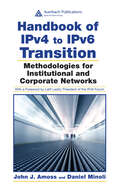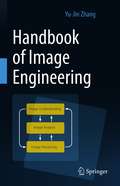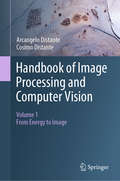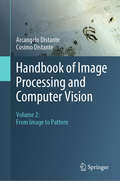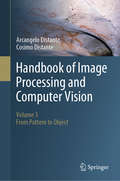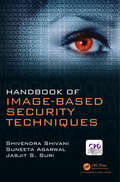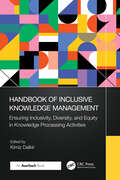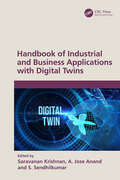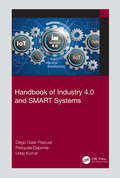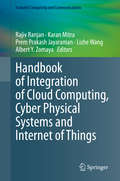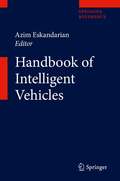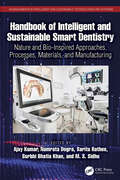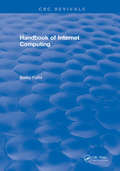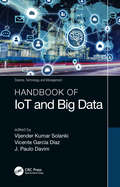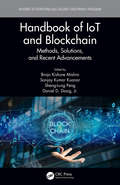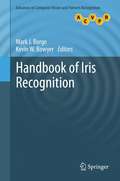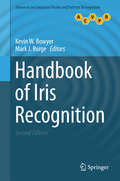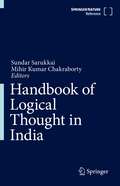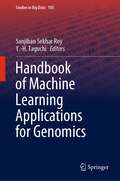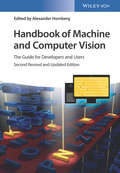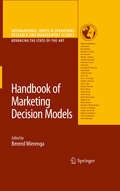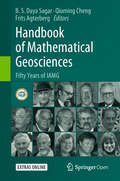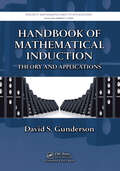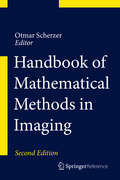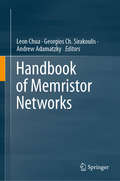- Table View
- List View
Handbook of IPv4 to IPv6 Transition: Methodologies for Institutional and Corporate Networks
by Daniel Minoli John J. AmossThe implementation of IPv6 is essential to the continued growth of the Internet and the development of new applications. The Handbook of IPv4 to IPv6 Transition Methodologies provides a wealth of best practices and procedures that will help corporations plan and implement a smooth transition to IPv6.A blueprint for successful transition, the Handbo
Handbook of Image Engineering
by Yu-Jin ZhangImage techniques have been developed and implemented for various purposes, and image engineering (IE) is a rapidly evolving, integrated discipline comprising the study of all the different branches of image techniques, and encompassing mathematics, physics, biology, physiology, psychology, electrical engineering, computer science and automation. Advances in the field are also closely related to the development of telecommunications, biomedical engineering, remote sensing, surveying and mapping, as well as document processing and industrial applications. IE involves three related and partially overlapping groups of image techniques: image processing (IP) (in its narrow sense), image analysis (IA) and image understanding (IU), and the integration of these three groups makes the discipline of image engineering an important part of the modern information era. This is the first handbook on image engineering, and provides a well-structured, comprehensive overview of this new discipline. It also offers detailed information on the various image techniques. It is a valuable reference resource for R&D professional and undergraduate students involved in image-related activities.
Handbook of Image Processing and Computer Vision: Volume 1: From Energy to Image
by Cosimo Distante Arcangelo DistanteAcross three volumes, the Handbook of Image Processing and Computer Vision presents a comprehensive review of the full range of topics that comprise the field of computer vision, from the acquisition of signals and formation of images, to learning techniques for scene understanding. The authoritative insights presented within cover all aspects of the sensory subsystem required by an intelligent system to perceive the environment and act autonomously. Volume 1 (From Energy to Image) examines the formation, properties, and enhancement of a digital image.Topics and features:• Describes the fundamental processes in the field of artificial vision that enable the formation of digital images from light energy• Covers light propagation, color perception, optical systems, and the analog-to-digital conversion of the signal• Discusses the information recorded in a digital image, and the image processing algorithms that can improve the visual qualities of the image• Reviews boundary extraction algorithms, key linear and geometric transformations, and techniques for image restoration• Presents a selection of different image segmentation algorithms, and of widely-used algorithms for the automatic detection of points of interest• Examines important algorithms for object recognition, texture analysis, 3D reconstruction, motion analysis, and camera calibration• Provides an introduction to four significant types of neural network, namely RBF, SOM, Hopfield, and deep neural networksThis all-encompassing survey offers a complete reference for all students, researchers, and practitioners involved in developing intelligent machine vision systems. The work is also an invaluable resource for professionals within the IT/software and electronics industries involved in machine vision, imaging, and artificial intelligence.Dr. Cosimo Distante is a Research Scientist in Computer Vision and Pattern Recognition in the Institute of Applied Sciences and Intelligent Systems (ISAI) at the Italian National Research Council (CNR). Dr. Arcangelo Distante is a researcher and the former Director of the Institute of Intelligent Systems for Automation (ISSIA) at the CNR. His research interests are in the fields of Computer Vision, Pattern Recognition, Machine Learning, and Neural Computation.
Handbook of Image Processing and Computer Vision: Volume 2: From Image to Pattern
by Cosimo Distante Arcangelo DistanteAcross three volumes, the Handbook of Image Processing and Computer Vision presents a comprehensive review of the full range of topics that comprise the field of computer vision, from the acquisition of signals and formation of images, to learning techniques for scene understanding. The authoritative insights presented within cover all aspects of the sensory subsystem required by an intelligent system to perceive the environment and act autonomously. Volume 2 (From Image to Pattern) examines image transforms, image restoration, and image segmentation.Topics and features:• Describes the fundamental processes in the field of artificial vision that enable the formation of digital images from light energy• Covers light propagation, color perception, optical systems, and the analog-to-digital conversion of the signal• Discusses the information recorded in a digital image, and the image processing algorithms that can improve the visual qualities of the image• Reviews boundary extraction algorithms, key linear and geometric transformations, and techniques for image restoration• Presents a selection of different image segmentation algorithms, and of widely-used algorithms for the automatic detection of points of interest• Examines important algorithms for object recognition, texture analysis, 3D reconstruction, motion analysis, and camera calibration• Provides an introduction to four significant types of neural network, namely RBF, SOM, Hopfield, and deep neural networksThis all-encompassing survey offers a complete reference for all students, researchers, and practitioners involved in developing intelligent machine vision systems. The work is also an invaluable resource for professionals within the IT/software and electronics industries involved in machine vision, imaging, and artificial intelligence.Dr. Cosimo Distante is a Research Scientist in Computer Vision and Pattern Recognition in the Institute of Applied Sciences and Intelligent Systems (ISAI) at the Italian National Research Council (CNR). Dr. Arcangelo Distante is a researcher and the former Director of the Institute of Intelligent Systems for Automation (ISSIA) at the CNR. His research interests are in the fields of Computer Vision, Pattern Recognition, Machine Learning, and Neural Computation.
Handbook of Image Processing and Computer Vision: Volume 3: From Pattern to Object
by Cosimo Distante Arcangelo DistanteAcross three volumes, the Handbook of Image Processing and Computer Vision presents a comprehensive review of the full range of topics that comprise the field of computer vision, from the acquisition of signals and formation of images, to learning techniques for scene understanding. The authoritative insights presented within cover all aspects of the sensory subsystem required by an intelligent system to perceive the environment and act autonomously. Volume 3 (From Pattern to Object) examines object recognition, neural networks, motion analysis, and 3D reconstruction of a scene.Topics and features:• Describes the fundamental processes in the field of artificial vision that enable the formation of digital images from light energy• Covers light propagation, color perception, optical systems, and the analog-to-digital conversion of the signal• Discusses the information recorded in a digital image, and the image processing algorithms that can improve the visual qualities of the image• Reviews boundary extraction algorithms, key linear and geometric transformations, and techniques for image restoration• Presents a selection of different image segmentation algorithms, and of widely-used algorithms for the automatic detection of points of interest• Examines important algorithms for object recognition, texture analysis, 3D reconstruction, motion analysis, and camera calibration• Provides an introduction to four significant types of neural network, namely RBF, SOM, Hopfield, and deep neural networksThis all-encompassing survey offers a complete reference for all students, researchers, and practitioners involved in developing intelligent machine vision systems. The work is also an invaluable resource for professionals within the IT/software and electronics industries involved in machine vision, imaging, and artificial intelligence.Dr. Cosimo Distante is a Research Scientist in Computer Vision and Pattern Recognition in the Institute of Applied Sciences and Intelligent Systems (ISAI) at the Italian National Research Council (CNR). Dr. Arcangelo Distante is a researcher and the former Director of the Institute of Intelligent Systems for Automation (ISSIA) at the CNR. His research interests are in the fields of Computer Vision, Pattern Recognition, Machine Learning, and Neural Computation.
Handbook of Image-based Security Techniques
by Jasjit S. Suri Shivendra Shivani Suneeta AgarwalThis book focuses on image based security techniques, namely visual cryptography, watermarking, and steganography. This book is divided into four sections. The first section explores basic to advanced concepts of visual cryptography. <P><P>The second section of the book covers digital image watermarking including watermarking algorithms, frameworks for modeling watermarking systems, and the evaluation of watermarking techniques. The next section analyzes steganography and steganalysis, including the notion, terminology and building blocks of steganographic communication. <P><P>The final section of the book describes the concept of hybrid approaches which includes all image-based security techniques. One can also explore various advanced research domains related to the multimedia security field in the final section. The book includes many examples and applications, as well as implementation using MATLAB, wherever required. <P><P>Features: <li>Provides a comprehensive introduction to visual cryptography, digital watermarking and steganography in one book <li>Includes real-life examples and applications throughout <li>Covers theoretical and practical concepts related to security of other multimedia objects using image based security techniques <li>Presents the implementation of all important concepts in MATLAB
Handbook of Inclusive Knowledge Management: Ensuring Inclusivity, Diversity, and Equity in Knowledge Processing Activities
by Kimiz DalkirHandbook of Inclusive Knowledge Management: Ensuring Inclusivity, Diversity, and Equity in Knowledge Processing Activities examines the role that diversity, equity and inclusivity (DEI) plays in the field and discipline of knowledge management (KM). With the premise that DEI is the inclusion and equal treatment of all types of people, things and viewpoints, the book aims to increase awareness of DEI among KM practitioners and researchers. It is a starting point for adopting knowledge processing activities that ensure all knowledge voices are represented in knowledge creation and capture. The book explains how this valuable knowledge can be shared and disseminated so that there is equitable access as well as knowledge. The focus of this handbook is on inclusivity in KM, its current state, specific challenges and an exploration of the best path forward.Currently, inclusivity does not appear to be on many KM road maps, and this book provides insights into the state-of-the-art of inclusivity in KM. In alignment with the book’s central theme, it presents a diverse range of perspectives that includes KM researchers, KM educators and KM practitioners. Addressing different stages of knowledge processing, as well as the KM bookends of KM culture, KM competencies and KM governance, the book features in-depth case studies to illustrate how inclusivity can be integrated into KM. The handbook concludes with concrete recommendations on how to integrate inclusivity into KM in organizations. Reviewing both the theory and practice of inclusive KM, the book helps readers gain actionable insights into an inclusive KM approach that includes standards, guidelines and checklists.
Handbook of Industrial and Business Applications with Digital Twins
by Saravanan Krishnan A. Jose Anand S. SendhilkumarA digital twin represents the indistinguishable digital counterpart of the physical object to simulate, monitor and test with real time synchronization. This book presents the framework and important key aspects of digital twins, including various technologies with coverage of the digital twins in various industry and business applications. It provides a background of modeling and simulation, computer sensor technology and other areas required creating the next wave of digital twins.Features: Presents exclusive material on industrial and business applications of digital twins Includes diversified digital twin applications with use cases Focuses on tools and methods for digital twins, platforms, application domains and industries Emphasizes advances and cutting-edge technologies throughout Reviews artificial intelligence (AI), fog/edge computing, industrial automation, blockchains and the Internet of Things (IoT) This book is aimed at researchers and graduate students in cloud computing, simulation, the IoT and computer engineering.
Handbook of Industry 4.0 and SMART Systems
by Uday Kumar Diego Galar Pascual Pasquale DaponteIndustry 4.0 refers to fourth generation of industrial activity characterized by smart systems and internet-based solutions. This book describes the fourth revolution based on instrumented, interconnected and intelligent assets. The different book chapters provide a perspective on technologies and methodologies developed and deployed leading to this concept. With an aim to increase performance, productivity and flexibility, major application area of maintenance through smart system has been discussed in detail. Applicability of 4.0 in transportation, energy and infrastructure is explored, with effects on technology, organisation and operations from a systems perspective.
Handbook of Integration of Cloud Computing, Cyber Physical Systems and Internet of Things (Scalable Computing and Communications)
by Lizhe Wang Albert Y. Zomaya Rajiv Ranjan Karan Mitra Prem Prakash JayaramanThis handbook covers recent advances in the integration of three areas, namely, cloud computing, cyber-physical systems, and the Internet of things which is expected to have a tremendous impact on our daily lives. It contains a total of thirteen peer-reviewed and edited chapters. This book covers topics such as context-aware cyber-physical systems, sustainable cloud computing, fog computing, and cloud monitoring; both the theoretical and practical aspects belonging to these topics are discussed. All the chapters also discuss open research challenges in the areas mentioned above. Finally, the handbook presents three use cases regarding healthcare, smart buildings and disaster management to assist the audience in understanding how to develop next-generation IoT- and cloud-enabled cyber-physical systems. This timely handbook is edited for students, researchers, as well as professionals who are interested in the rapidly growing fields of cloud computing, cyber-physical systems, and the Internet of things.
Handbook of Intelligent Vehicles
by Azim EskandarianThe Handbook of Intelligent Vehicles provides a complete coverage of the fundamentals, new technologies, and sub-areas essential to the development of intelligent vehicles; it also includes advances made to date, challenges, and future trends. Significant strides in the field have been made to date; however, so far there has been no single book or volume which captures these advances in a comprehensive format, addressing all essential components and subspecialties of intelligent vehicles, as this book does. Since the intended users are engineering practitioners, as well as researchers and graduate students, the book chapters do not only cover fundamentals, methods, and algorithms but also include how software/hardware are implemented, and demonstrate the advances along with their present challenges. Research at both component and systems levels are required to advance the functionality of intelligent vehicles. This volume covers both of these aspects in addition to the fundamentals listed above.
Handbook of Intelligent and Sustainable Smart Dentistry: Nature and Bio-Inspired Approaches, Processes, Materials, and Manufacturing (Advancements in Intelligent and Sustainable Technologies and Systems)
by Ajay Kumar Sidhu Surbhi Bhatia Khan Sarita Rathee Namrata DograWith the exponential growth of science and technology, the delivery of dental care has shifted from conventional methods to intelligent techniques. In addition to adapting intelligent techniques, sustainable dental practice is of the utmost importance. Eco-friendly dentistry, sustainable dentistry, or green dentistry are approaches that reduce the environmental impact of dental practice and help safeguard planetary and community well-being. This handbook provides the latest and most comprehensive evidence-based guidance on intelligent and sustainable approaches in dentistry.Handbook of Intelligent and Sustainable Smart Dentistry: Nature and Bio-Inspired Approaches, Processes, Materials, and Manufacturing highlights how Dentistry 4.0 has come to the rescue after COVID-19 and how it has helped in providing needed e-healthcare. This handbook bridges the gap between research and development in the field of smart dentistry for professionals and clinicians. Intelligent materials, equipment, instrumentation, and the latest behavior management techniques and how these techniques provide superior care and treatment to society are explored in detail. The scope of nature-inspired techniques and procession, along with green solutions, are also discussed in this one-of-a-kind handbook.This valuable handbook is a single-stop solution for practitioners, researchers, scholars, students, academicians, and clinicians interested in updating their knowledge on intelligent and sustainable dentistry. The handbook will bestow the readers with not only theoretical knowledge but will equip them with clinical skills as well.
Handbook of Internet Computing (Internet And Communications Ser. #5)
by Borko FurhtScientists in different geographical locations conduct real-time experiments in a virtual shared workspace. E-commerce provides an emerging market for businesses large and small. E-mail, Servers, and Enterprise Resources Planning have revolutionized businesses on every level. People from all over the globe gather in chat rooms. The Internet is here to stay and Internet technologies and applications continue to grow and evolve.The Handbook of Internet Computing presents comprehensive coverage of all technical issues related to the Internet and its applications. It addresses hot topics such as Internet architectures, content-based multimedia retrieval on the Internet, Web-based collaboration, Web search engines, digital libraries, and more. Real-life examples illustrate the concepts so that technical, non-technical and business people can quickly grasp the fundamentals.
Handbook of IoT and Big Data (Science, Technology, and Management)
by J. Paulo Davim Vijender Kumar Solanki Vicente García DíazThis multi-contributed handbook focuses on the latest workings of IoT (internet of Things) and Big Data. As the resources are limited, it's the endeavor of the authors to support and bring the information into one resource. The book is divided into 4 sections that covers IoT and technologies, the future of Big Data, algorithms, and case studies showing IoT and Big Data in various fields such as health care, manufacturing and automation. Features Focuses on the latest workings of IoT and Big Data Discusses the emerging role of technologies and the fast-growing market of Big Data Covers the movement toward automation with hardware, software, and sensors, and trying to save on energy resources Offers the latest technology on IoT Presents the future horizons on Big Data
Handbook of IoT and Blockchain: Methods, Solutions, and Recent Advancements (Internet of Everything (IoE))
by Brojo Kishore Mishra, Sanjay Kumar Kuanar, Sheng-Lung Peng, and Daniel D. DasigHandbook of IoT and Blockchain: Methods, solutions, and Recent Advancements includes contributions from around the globe on recent advances and findings in the domain of Internet of Things (IoT) and Blockchain. Chapters include theoretical analysis, practical implications, and extensive surveys with analysis on methods, algorithms, and processes for new product development. IoT and Blockchain are the emerging topics in the current manufacturing scenario.This handbook includes recent advances; showcases the work of research around the globe; offers theoretical analysis and practical implications; presents extensive surveys with analysis, new contributions, and proposals on methods, algorithms, and processes; and also covers recent advances from quantitative and qualitative articles, case studies, conceptual works, and theoretical backing. This handbook will be of interest to graduate students, researchers, academicians, institutions, and professionals that are interested in exploring the areas of IoT and Blockchain.
Handbook of Iris Recognition
by Mark J. Burge Kevin BowyerThis authoritative collection introduces the reader to the state of the art in iris recognition technology. Topics and features: with a Foreword by the "father of iris recognition," Professor John Daugman of Cambridge University; presents work from an international selection of preeminent researchers, reflecting the uses of iris recognition in many different social contexts; provides viewpoints from researchers in government, industry and academia, highlighting how iris recognition is both a thriving industry and an active research area; surveys previous developments in the field, and covers topics ranging from the low-level (e.g., physics of iris image acquisition) to the high level (e.g., alternative non-Daugman approaches to iris matching); introduces many active and open areas of research in iris recognition, including cross-wavelength matching and iris template aging. This book is an essential resource for anyone wishing to improve their understanding of iris recognition technology.
Handbook of Iris Recognition
by Mark J. Burge Kevin W. BowyerThe definitive work on iris recognition technology, this comprehensive handbook presents a broad overview of the state of the art in this exciting and rapidly evolving field. Revised and updated from the highly-successful original, this second edition has also been considerably expanded in scope and content, featuring four completely new chapters. Features: provides authoritative insights from an international selection of preeminent researchers from government, industry, and academia; reviews issues covering the full spectrum of the iris recognition process, from acquisition to encoding; presents surveys of topical areas, and discusses the frontiers of iris research, including cross-wavelength matching, iris template aging, and anti-spoofing; describes open source software for the iris recognition pipeline and datasets of iris images; includes new content on liveness detection, correcting off-angle iris images, subjects with eye conditions, and implementing software systems for iris recognition.
Handbook of Logical Thought in India
by Sundar Sarukkai Mihir Kumar ChakrabortyThis collection of articles is unique in the way it approaches established material on the various logical traditions in India. Instead of classifying these traditions within Schools as is the usual approach, the material here is classified into sections based on themes ranging from Fundamentals of ancient logical traditions to logic in contemporary mathematics and computer science. This collection offers not only an introduction to the key themes in different logical traditions such as Nyaya, Buddhist and Jaina, it also highlights certain unique characteristics of these traditions as well as contribute new material in the relationship of logic to aesthetics, linguistics, Kashmir Saivism as well as the forgotten Tamil contribution to logic.
Handbook of Machine Learning Applications for Genomics (Studies in Big Data #103)
by Sanjiban Sekhar Roy Y. H. TaguchiCurrently, machine learning is playing a pivotal role in the progress of genomics. The applications of machine learning are helping all to understand the emerging trends and the future scope of genomics. This book provides comprehensive coverage of machine learning applications such as DNN, CNN, and RNN, for predicting the sequence of DNA and RNA binding proteins, expression of the gene, and splicing control. In addition, the book addresses the effect of multiomics data analysis of cancers using tensor decomposition, machine learning techniques for protein engineering, CNN applications on genomics, challenges of long noncoding RNAs in human disease diagnosis, and how machine learning can be used as a tool to shape the future of medicine. More importantly, it gives a comparative analysis and validates the outcomes of machine learning methods on genomic data to the functional laboratory tests or by formal clinical assessment. The topics of this book will cater interest to academicians, practitioners working in the field of functional genomics, and machine learning. Also, this book shall guide comprehensively the graduate, postgraduates, and Ph.D. scholars working in these fields.
Handbook of Machine and Computer Vision: The Guide for Developers and Users
by Alexander HornbergThe second edition of this accepted reference work has been updated to reflect the rapid developments in the field and now covers both 2D and 3D imaging. Written by expert practitioners from leading companies operating in machine vision, this one-stop handbook guides readers through all aspects of image acquisition and image processing, including optics, electronics and software. The authors approach the subject in terms of industrial applications, elucidating such topics as illumination and camera calibration. Initial chapters concentrate on the latest hardware aspects, ranging from lenses and camera systems to camera-computer interfaces, with the software necessary discussed to an equal depth in later sections. These include digital image basics as well as image analysis and image processing. The book concludes with extended coverage of industrial applications in optics and electronics, backed by case studies and design strategies for the conception of complete machine vision systems. As a result, readers are not only able to understand the latest systems, but also to plan and evaluate this technology. With more than 500 images and tables to illustrate relevant principles and steps.
Handbook of Marketing Decision Models
by Berend WierengaMarketing models is a core component of the marketing discipline. The recent developments in marketing models have been incredibly fast with information technology (e.g., the Internet), online marketing (e-commerce) and customer relationship management (CRM) creating radical changes in the way companies interact with their customers. This has created completely new breeds of marketing models, but major progress has also taken place in existing types of marketing models. Handbook of Marketing Decision Models presents the state of the art in marketing decision models. The book deals with new modeling areas, such as customer relationship management, customer value and online marketing, as well as recent developments in other advertising, sales promotions, sales management, and competition are dealt with. New developments are in consumer decision models, models for return on marketing, marketing management support systems, and in special techniques such as time series and neural nets.
Handbook of Mathematical Geosciences: Fifty Years of IAMG
by Frits Agterberg B.S. Daya Sagar Qiuming ChengThis Open Access handbook published at the IAMG's 50th anniversary, presents a compilation of invited path-breaking research contributions by award-winning geoscientists who have been instrumental in shaping the IAMG. It contains 45 chapters that are categorized broadly into five parts (i) theory, (ii) general applications, (iii) exploration and resource estimation, (iv) reviews, and (v) reminiscences covering related topics like mathematical geosciences, mathematical morphology, geostatistics, fractals and multifractals, spatial statistics, multipoint geostatistics, compositional data analysis, informatics, geocomputation, numerical methods, and chaos theory in the geosciences.
Handbook of Mathematical Induction: Theory and Applications (Discrete Mathematics and Its Applications)
by David S. GundersonHandbook of Mathematical Induction: Theory and Applications shows how to find and write proofs via mathematical induction. This comprehensive book covers the theory, the structure of the written proof, all standard exercises, and hundreds of application examples from nearly every area of mathematics.In the first part of the book, the author discuss
Handbook of Mathematical Methods in Imaging
by Otmar ScherzerThe Handbook of Mathematical Methods in Imaging provides a comprehensive treatment of the mathematical techniques used in imaging science. The material is grouped into two central themes, namely, Inverse Problems (Algorithmic Reconstruction) and Signal and Image Processing. Each section within the themes covers applications (modeling), mathematics, numerical methods (using a case example) and open questions. Written by experts in the area, the presentation is mathematically rigorous. The entries are cross-referenced for easy navigation through connected topics. Available in both print and electronic forms, the handbook is enhanced by more than 150 illustrations and an extended bibliography. It will benefit students, scientists and researchers in applied mathematics. Engineers and computer scientists working in imaging will also find this handbook useful.
Handbook of Memristor Networks
by Leon Chua Georgios Ch. Sirakoulis Andrew AdamatzkyThis Handbook presents all aspects of memristor networks in an easy to read and tutorial style. Including many colour illustrations, it covers the foundations of memristor theory and applications, the technology of memristive devices, revised models of the Hodgkin-Huxley Equations and ion channels, neuromorphic architectures, and analyses of the dynamic behaviour of memristive networks. It also shows how to realise computing devices, non-von Neumann architectures and provides future building blocks for deep learning hardware.With contributions from leaders in computer science, mathematics, electronics, physics, material science and engineering, the book offers an indispensable source of information and an inspiring reference text for future generations of computer scientists, mathematicians, physicists, material scientists and engineers working in this dynamic field.
